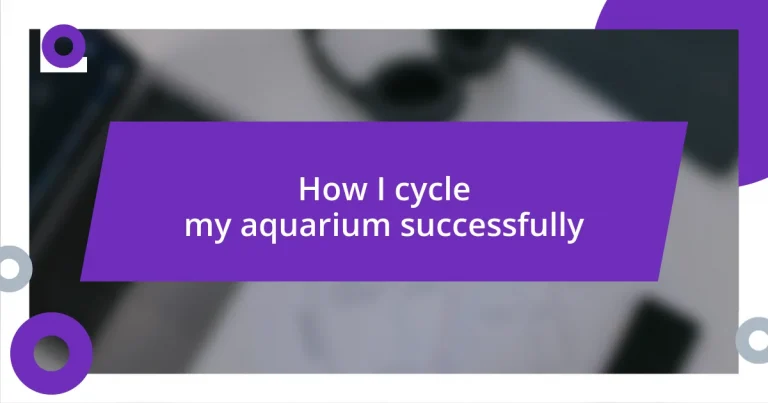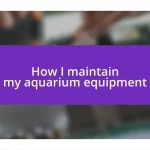Key takeaways:
- The nitrogen cycle is essential for breaking down toxic waste in aquariums, highlighting the need for beneficial bacteria to maintain a safe environment.
- Proper cycling of an aquarium prevents ammonia spikes, establishes beneficial bacteria, and supports a balanced ecosystem, ultimately reducing stress for fish.
- Regular monitoring of water parameters and troubleshooting common issues, such as ammonia and nitrite spikes, are crucial for maintaining a healthy aquarium cycle.
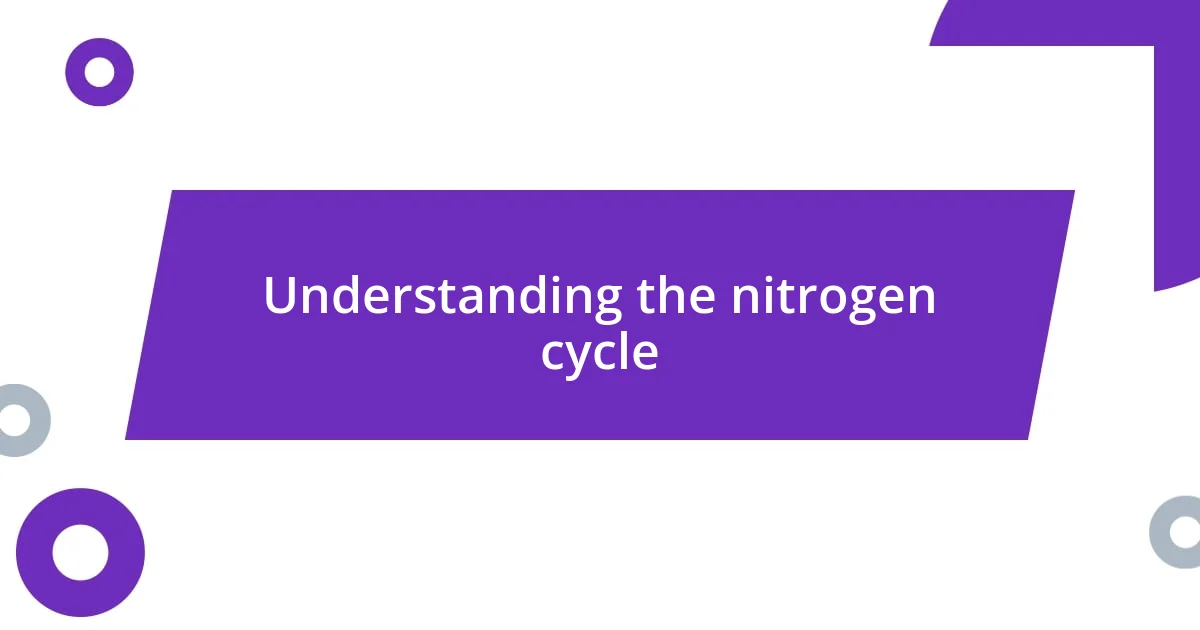
Understanding the nitrogen cycle
The nitrogen cycle is a vital process that maintains the health of your aquarium. In my experience, understanding this cycle can feel like deciphering a complex riddle. Why does it matter so much? It’s all about breaking down fish waste and uneaten food into less harmful substances and ensuring your aquatic environment thrives.
At the heart of this cycle are beneficial bacteria that transform toxic ammonia from fish waste into nitrite, and then into nitrate. I remember when I first set up my aquarium, I was both excited and anxious. Watching the ammonia levels spike was nerve-wracking—was I doing everything right? Knowing that these bacteria were working behind the scenes gave me some peace of mind.
This transformation is key because, while nitrates can be harmful in high levels, they’re less toxic and can be managed through regular water changes and plants that absorb them. Have you ever observed how quickly your plants respond to a little extra feeding? It’s amazing to see how interconnected all these elements are, reflecting the delicate balance of life inside your tank.
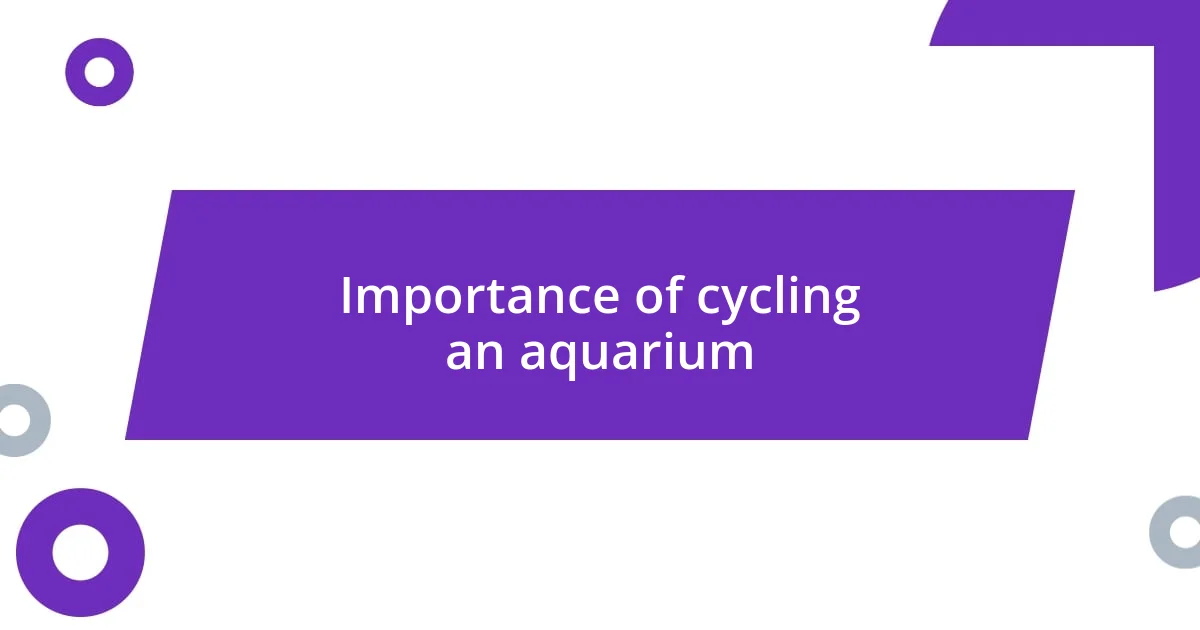
Importance of cycling an aquarium
Cycling an aquarium is essential for establishing a stable and healthy environment for your fish. I can’t stress enough how important it was for me to properly cycle my tank before adding my first fish. Initially, I underestimated this process, but the first few weeks were a rollercoaster of emotions—from excitement to anxiety over water quality. When I finally saw the beneficial bacteria flourish, and the ammonia levels drop, it felt like a huge weight lifted off my shoulders.
Here are some critical reasons why cycling is important:
- Prevents deadly spikes in ammonia: Without cycling, you risk your fish’s health due to toxic ammonia build-up.
- Establishes beneficial bacteria colonies: These are crucial for breaking down waste and maintaining water quality.
- Creates a balanced ecosystem: Cycling helps develop a stable environment where plants, bacteria, and fish can coexist harmoniously.
- Reduces stress for fish: A well-cycled tank minimizes fluctuations in water quality, making it less stressful for your aquatic pets.
- Supports long-term success: A properly cycled aquarium leads to less frequent problems down the road, allowing you to enjoy your hobby more fully.
Each of these points significantly shapes the aquarium experience. Each time I observed my fish thriving in a well-cycled tank, I couldn’t help but feel a sense of accomplishment. It’s not just science; it’s genuine joy to watch life flourish because of a little preparation.
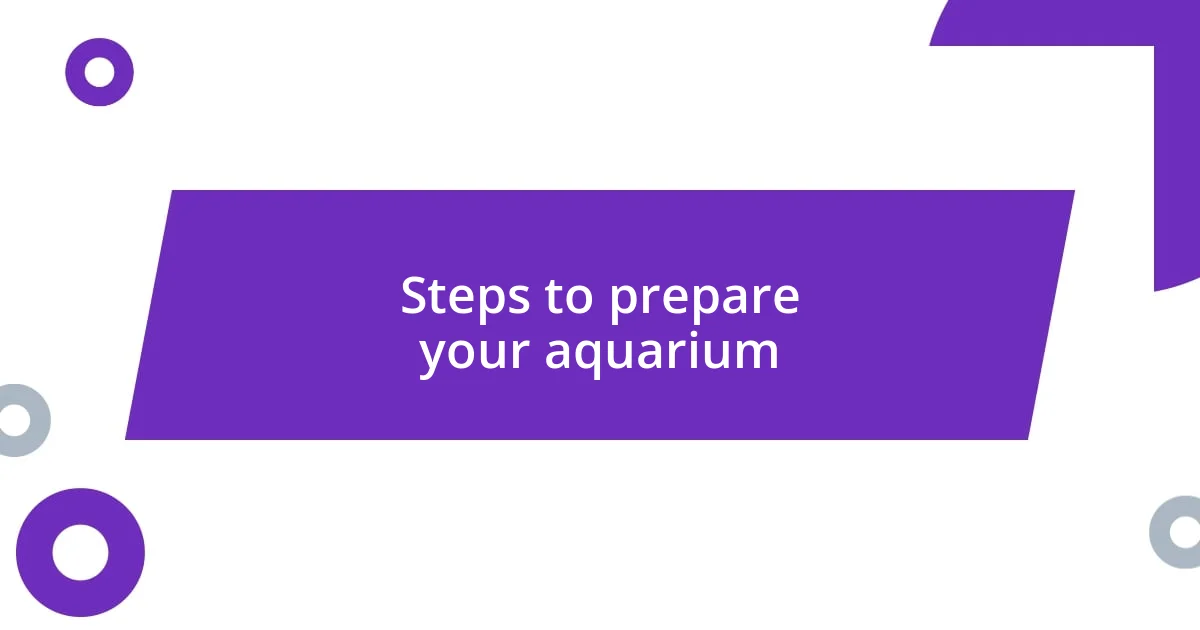
Steps to prepare your aquarium
Preparing your aquarium is a crucial step that sets the stage for success. First and foremost, you’ll want to thoroughly clean your tank. I can recall the first time I set up my tank; I was so eager to start that I almost skipped this part. However, taking the time to rinse the tank and decorations with water (without soap, of course) made a world of difference. It ensured that there were no harmful residues left behind that could harm my future aquatic inhabitants.
Next, filling your aquarium with dechlorinated water is essential. I learned this lesson the hard way. On one occasion, I filled my tank without considering the chlorine in tap water, and it negatively impacted the delicate balance I was trying to achieve. Using a water conditioner can help neutralize chlorine, so your fish can thrive from day one. Ensuring proper temperature settings is just as important—not all fish appreciate cold surprises, and I’ve seen how cranky fish can get!
To keep track of progress, I like to maintain a checklist as I prepare my aquarium. It helps me focus on each step while allowing me to impart some personal touches. Remember, patience is key during this preparation phase; taking it slow often leads to spectacular results! Here’s a handy comparison table to clarify some of the preparatory steps you’ll want to consider:
| Step | Description |
|---|---|
| Clean the Tank | Thoroughly rinse the tank with water (no soap) to remove any harmful residues. |
| Dechlorinate Water | Use a water conditioner to remove chlorine before filling your tank. |
| Set the Temperature | Adjust the heater to the appropriate temperature for the fish species you’ll keep. |
| Make a Checklist | Create a list to track necessary steps, and personalize each part to reflect your style. |

Choosing the right fish species
Choosing the right fish species is like setting the foundation of a beautiful home; it influences everything that follows. When I first started, I chose species based solely on their looks, without considering their compatibility. I quickly learned that not all fish get along, and it’s heart-wrenching to witness stress and aggression in your tank. So, take your time to research species that will coexist peacefully—trust me, it’s worth the effort.
Another thing I’ve discovered is that specific species have unique environmental needs. For instance, some prefer higher temperatures and softer water, while others thrive in cooler, harder conditions. I remember my initial excitement over a dazzling Betta fish, only to realize later that its needs clashed dramatically with my tank’s setup. It’s a good practice to match the conditions in your tank to the specific requirements of the fish you wish to keep.
Lastly, consider the size and growth potential of your fish. I made the mistake of buying small juvenile fish without thinking about how large they’d grow. I fondly remember my little Tetras swimming freely, but it wasn’t long before they were crowded by larger, territorial species. It was stressful for them and for me as an aquarist. Always contemplate how the size of your fish will impact the tank environment and overall harmony—it can save you a lot of heartache down the road.
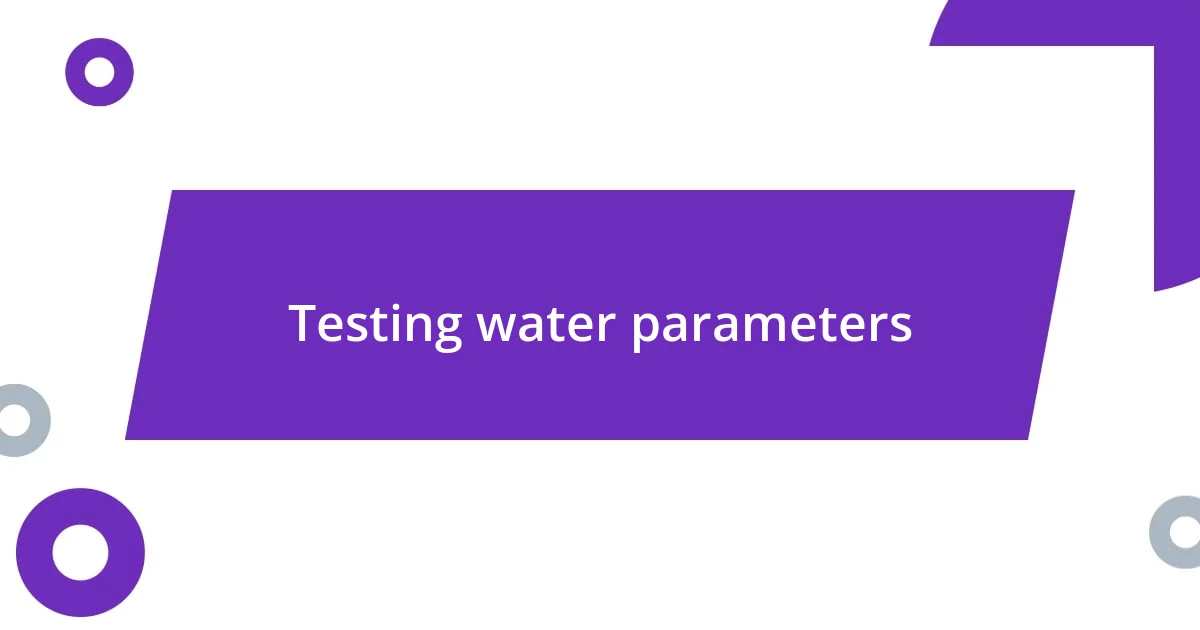
Testing water parameters
When it comes to testing water parameters, I find it fascinating how much it can reveal about the health of your aquarium. Regular testing for ammonia, nitrite, and nitrate levels is crucial, especially during the cycling process. I remember a time when I could almost feel my heart race as I watched the ammonia spike unexpectedly. The moment I checked the levels with a reliable test kit, I realized the importance of staying proactive.
But it’s not just about those three critical parameters. pH, hardness, and temperature also play their roles in creating a balanced ecosystem. I’ll never forget the intense moment when I mistakenly assumed my pH was fine—only to discover later that it was far too high for my fish. I had to act quickly to buffer it down. Reflecting on that experience, I’ve learned that a comprehensive testing routine can save you from such heart-stopping surprises.
After testing, I advise jotting down your readings. It may seem tedious, but creating a log has helped me track patterns over time and anticipate any changes that could affect my aquatic friends. Have you thought about how often you’re checking your water parameters? I often find that consistency not only brings peace of mind but also helps in adjusting conditions effectively.
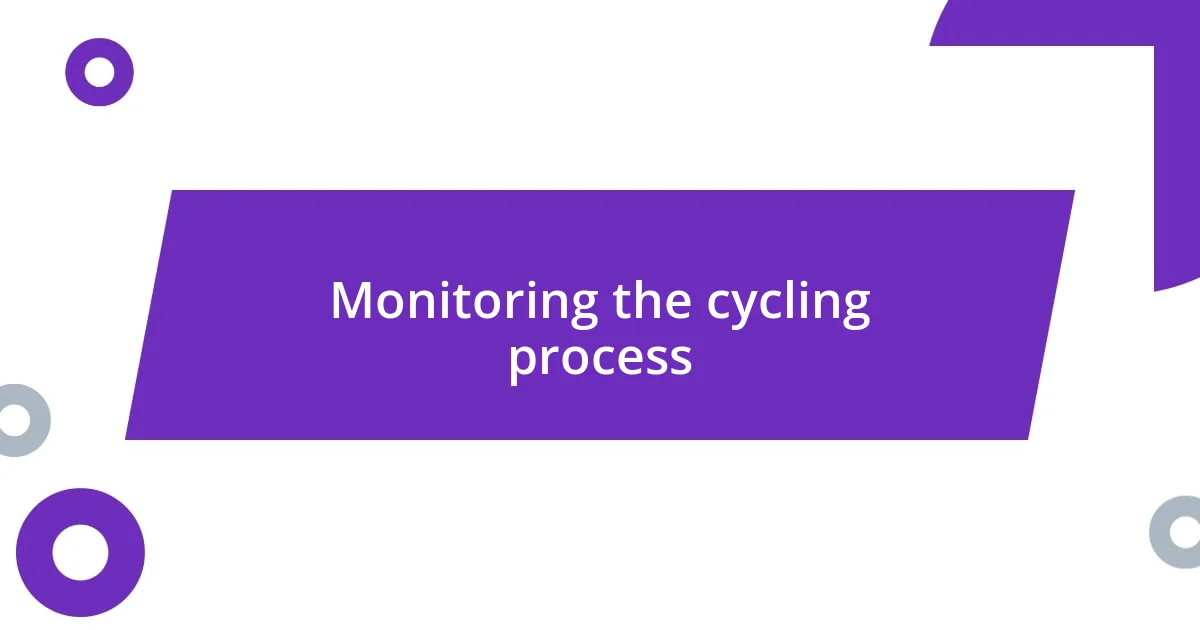
Monitoring the cycling process
When monitoring the cycling process, I can’t stress enough how crucial it is to observe changes in your tank over time. The first time I cycled my aquarium, I became a bit obsessed with checking levels daily. I remember one afternoon, I gleefully noticed a drop in ammonia and a rise in nitrite—those small victories can feel monumental. Have you experienced that sense of relief? It’s a reminder that your efforts are paying off and the ecosystem is gradually balancing itself.
Keeping a close eye on the time it takes for each stage of cycling can also provide valuable insights. I distinctly recall my surprise when the nitrite levels began dropping sooner than expected, leading to a robust surge in nitrates. I learned that every aquarium is unique; one might cycle quickly, while another takes its sweet time. Tracking these nuances helps you understand your specific setup better, allowing for a more tailored approach.
Finally, be patient and recognize that fluctuations are part of the process. I vividly recall the day when I noticed a slight algae bloom – my first initial reaction was panic. Yet, understanding that these occurrences are typical in a new tank helped me take a deep breath. Instead of stressing, I reminded myself that it’s all part of establishing a thriving aquarium. How do you manage those peaks and valleys during your cycling journey? Embracing the unpredictable nature of cycling not only fosters resilience but also enriches your experience as an aquarist.
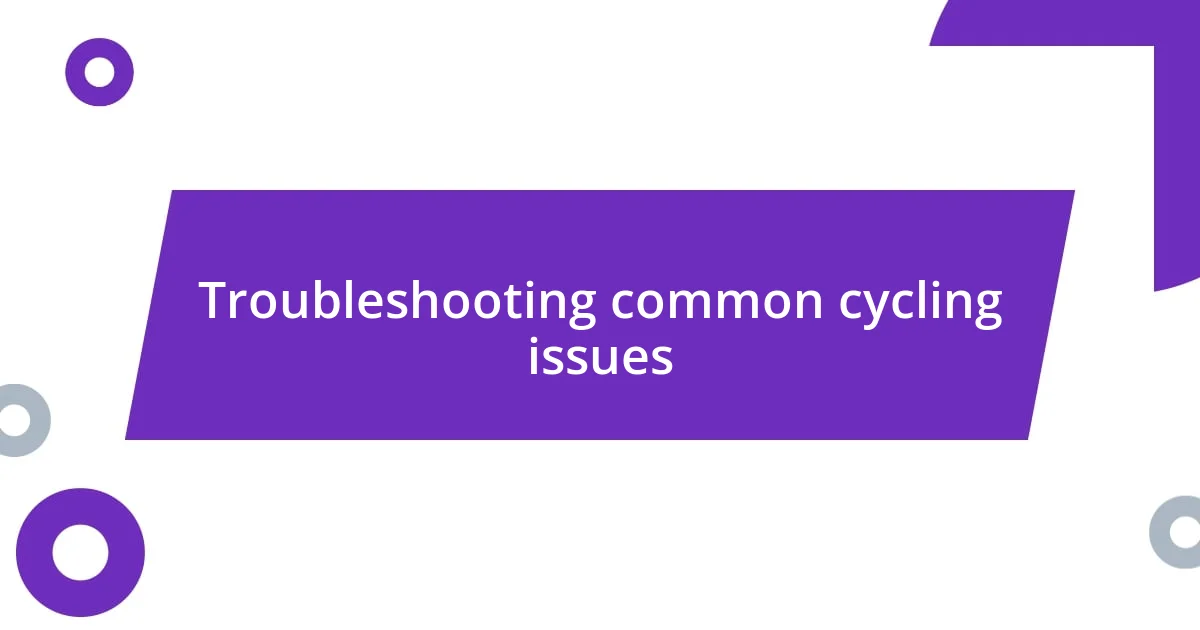
Troubleshooting common cycling issues
It’s not uncommon to face setbacks during the cycling process, and I’ve had my fair share. I once battled an unexpected rise in ammonia that left me feeling frustrated and unsure of my next steps. Rather than panicking, I decided to do a partial water change. This helped reduce the ammonia levels significantly, and I’ve learned that it’s often a simple solution to keep the cycle on track. Have you ever felt overwhelmed by a spike in your water parameters? Sometimes, addressing these initial hiccups head-on can turn a potentially alarming situation into a learning opportunity.
What about the infamous “nitrite spike”? I can still recall the day it hit – I felt a wave of panic wash over me as I realized my nitrite levels were through the roof. After a bit of research, I discovered that using beneficial bacteria supplements could help mitigate the impact. That was a game changer for me! These products can speed up the establishment of your biofilter, but make sure to follow instructions closely. Have you tried this method before? It’s all about finding the right tools that suit your aquarium’s unique needs.
Lastly, don’t underestimate the role of patience in troubleshooting cycling issues. I distinctly remember watching my tank transform, only to find myself fretting over a minor fluctuation in nitrate levels. Instead of diving into corrections, I took a step back and reflected on the bigger picture. Remember, each aquarium is a living, breathing ecosystem. Embracing the unpredictable nature of cycling – it often demands a level of relinquishment that can feel daunting, but it ultimately leads to a more successful and resilient aquarium. How do you find balance between taking action and allowing nature to take its course?












